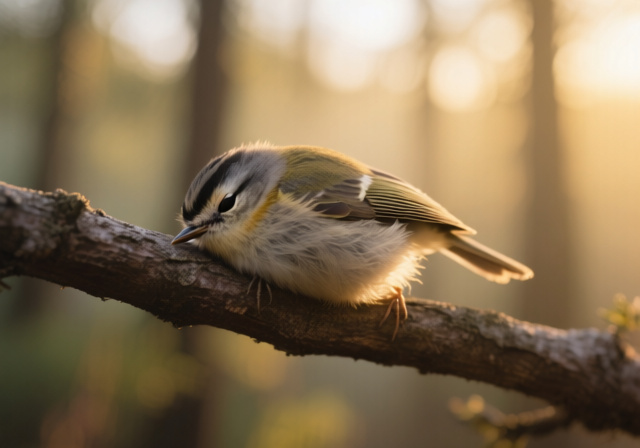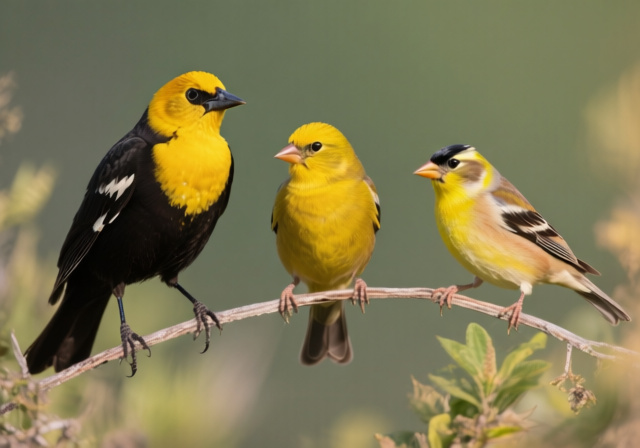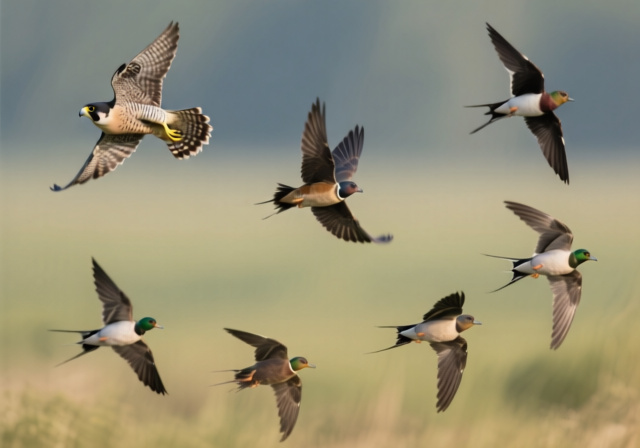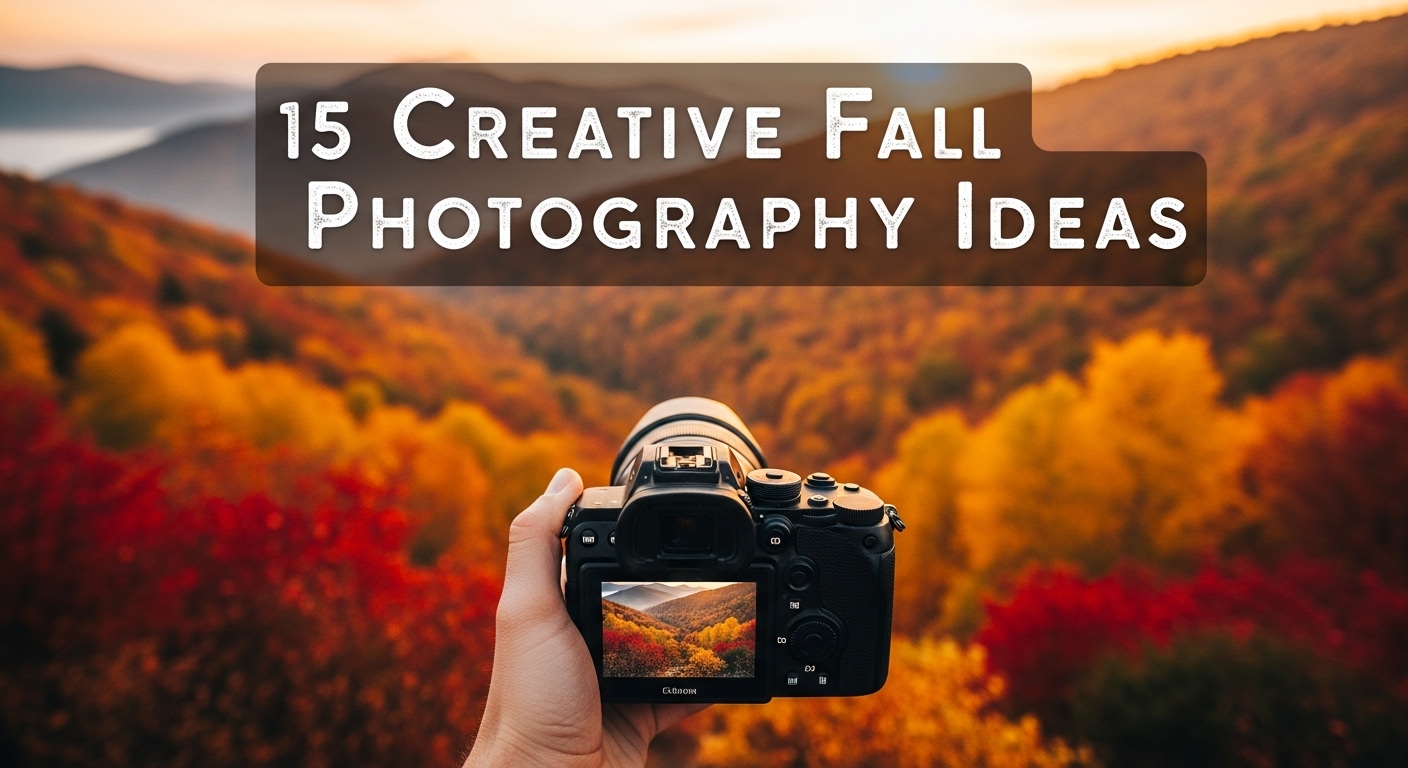



Birds with yellow heads represent some of North America’s most striking and photogenic species, offering incredible opportunities for wildlife photographers. From the iconic Yellow-headed Blackbird’s bold golden crown to the subtle yellow cap of a Wilson’s Warbler, these birds capture the imagination with their vibrant plumage and fascinating behaviors.
The most notable birds with yellow heads include the Yellow-headed Blackbird (marsh dweller with striking contrast), Western Tanager (mountain beauty with golden-orange head), American Goldfinch (bright yellow breeding male), Evening Grosbeak (bold yellow forehead), Scott’s Oriole (desert specialist with golden hood), Common Yellowthroat (masked warbler), and Wilson’s Warbler (tiny traveler with distinctive yellow cap).
As wildlife photographers with over 20 years of experience capturing avian subjects across North America, we’ve learned that yellow-headed birds require specific techniques and timing to photograph effectively. Their vibrant plumage presents unique challenges – from exposure compensation to capturing the right light that makes those golden feathers truly pop.
In this comprehensive guide, you’ll discover 15 stunning yellow-headed species, complete with field identification tips, preferred habitats, seasonal timing, and professional photography techniques that will help you capture breathtaking images of these beautiful birds.
The Yellow-headed Blackbird (Xanthocephalus xanthocephalus) is perhaps the most dramatic of all yellow-headed birds, with its glossy black body contrasted against a brilliant golden-yellow head and chest. Males measure 8.3-10.2 inches in length with a wingspan of 13-16 inches, making them noticeably larger than their Red-winged Blackbird cousins.
These marsh dwellers are most commonly found in western North America’s wetlands, where they establish territories in cattail marshes during breeding season from April through July. Their distinctive call – a harsh, metallic sound resembling a rusty farm gate hinge – often reveals their presence before they’re spotted.
For photographers, the best opportunities occur during early morning hours when males perch prominently on cattail tops, singing their territorial songs. Use a telephoto lens of 400mm or longer to maintain respectful distance, and set exposure compensation to +1 to prevent the yellow head from appearing underexposed against dark marsh backgrounds.
The Western Tanager (Piranga ludoviciana) displays one of nature’s most striking color combinations – a brilliant orange-yellow head contrasting with a black back and wings, and a bright yellow body. During breeding season, males develop their spectacular plumage to attract mates in coniferous forests across western North America.
These medium-sized songbirds (6.3-7.5 inches) prefer higher elevations, typically above 5,000 feet, where they feed on insects and berries among pine and fir trees. Their slow, deliberate movements and tendency to perch still for brief periods make them excellent photography subjects when located.
Photograph Western Tanagers during early morning when they’re most active foraging in forest canopies. Use a fast shutter speed (1/1000s or faster) to freeze their movements, and consider a shallow depth of field (f/4-f/5.6) to separate them from busy backgrounds. Their orange-yellow head reflects light differently than pure yellow – adjust white balance to preserve those warm tones.
The male American Goldfinch (Spinus tristis) in breeding plumage is pure sunshine – brilliant lemon-yellow covering most of its body with a black cap and black wings marked by white bars. These small songbirds (4.3-5.1 inches) undergo a dramatic molt in spring, transforming from dull olive-brown winter plumage to stunning breeding colors.
Found across most of North America, American Goldfinches prefer open fields, meadows, and gardens with abundant seed sources. They’re late nesters, typically breeding in July and August when thistle and milkweed seeds are plentiful. Their distinctive bouncy, undulating flight pattern and sweet “po-ta-to-chip” call make them easy to identify.
Photograph goldfinches during mid-morning hours (9-11 AM) when they actively feed on sunflower and thistle heads. A 300mm lens with extension tubes works well for close-up portraits, and their habit of returning repeatedly to the same feeding perch allows for patient observation and multiple photo opportunities.
The Evening Grosbeak (Coccothraustes vespertinus) is a robust, striking bird with a prominent yellow forehead and supercilium (eyebrow stripe) contrasting against its brownish-gray body. Males also feature distinctive white wing patches visible in flight. These hefty finches (6.3-7.9 inches) possess exceptionally thick bills designed for cracking hard seeds.
Irregular migrants, Evening Grosbeaks move in response to food availability, often appearing in large flocks at backyard feeders during winter months. They’re found primarily in coniferous and mixed forests across northern North America, though their range can expand dramatically during irruption years.
For photography, Evening Grosbeaks offer wonderful opportunities as they often remain stationary while cracking large seeds. Use a telephoto lens (200-400mm) to capture frame-filling portraits, and set your aperture to f/8 to ensure their entire head and massive bill remain in sharp focus. Their bold yellow markings photograph well in both direct and diffused light.
Scott’s Oriole (Icterus parisorum) epitomizes desert elegance with its striking black and yellow coloration – a black head, back, and wings provide dramatic contrast against a brilliant yellow body and shoulders. These medium-sized orioles (7.9-9.4 inches) are perfectly adapted to arid environments of the southwestern United States and Mexico.
Look for Scott’s Orioles in desert habitats with yucca plants, where they often build their pendulous nests hanging from yucca leaves. They’re also found in juniper woodlands and mountain canyons, especially where agave and nectar-producing flowers are abundant. Their rich, flute-like song often reveals their presence in sparse desert landscapes.
Photograph these desert beauties during early morning hours when they actively forage for insects and nectar. The harsh desert light can be challenging – seek shaded areas or wait for the golden hour (first hour after sunrise) when the light is soft and warm. A 400mm lens helps maintain distance in open desert terrain.
The male Common Yellowthroat (Geothlypis trichas) is instantly recognizable with its bold black mask contrasting against a bright yellow throat, breast, and forehead. This small warbler (4.7-5.1 inches) is one of North America’s most widespread and abundant warblers, found in marshy areas, wet meadows, and streamside thickets across virtually the entire continent.
Common Yellowthroats are skulkers, often remaining hidden in dense vegetation near water. Their distinctive “wichity-wichity-wichity” song frequently reveals their presence before they’re seen. They’re incredibly territorial during breeding season, often responding dramatically to pishing sounds made by birders.
Photographing these secretive warblers requires patience and a different approach. Use a shorter telephoto lens (200-300mm) for better maneuverability in thick vegetation, and focus on behavior shots rather than perfect portraits. Early morning light filtering through marsh vegetation creates beautiful, soft illumination for their yellow plumage.
Wilson’s Warbler (Cardellina pusilla) is a tiny energetic bird distinguished by the male’s distinctive black cap set against bright yellow underparts and olive-green upperparts. These diminutive warblers (4.3-4.7 inches) are among the most active and constantly moving of all wood warblers, making them challenging but rewarding photography subjects.
Found across western and northern North America during breeding season, Wilson’s Warblers prefer willow thickets, alder groves, and streamside vegetation with dense understory. They’re long-distance migrants, traveling as far south as Central America for winter. Their constant tail-wagging behavior makes them easy to identify even in poor viewing conditions.
Success with Wilson’s Warblers requires anticipation and fast autofocus systems. Use burst mode (8+ fps) to capture their brief moments of stillness, and pre-focus on likely perches near their foraging areas. A 300mm prime lens with a wide aperture (f/2.8-f/4) performs well in the dim light of their preferred habitats.
The Yellow Warbler (Setophaga petechia) is pure radiance – males are entirely golden-yellow with reddish streaks on their breast. These cheerful songbirds (4.7-5.1 inches) are among North America’s most widespread warblers, found from coast to coast in willow thickets, streamside vegetation, and even suburban gardens and parks.
Yellow Warblers have one of the most recognizable songs in the bird world – a series of sweet notes that sound like “sweet, sweet, sweet, I’m so sweet.” They’re incredibly adaptable birds, thriving in both pristine wetlands and urban parks where suitable vegetation exists. Their habit of singing from exposed perches makes them relatively easy to locate and observe.
Photograph Yellow Warblers during the first two hours after sunrise when they’re most actively singing and feeding. Their preference for lower vegetation allows for eye-level photography opportunities. Use a 300-400mm lens with image stabilization, as their constant movement requires steady support for sharp images.
The Saffron Finch (Sicalis flaveola) is a vibrant South American species that has established small populations in southern Florida and Hawaii. Males display brilliant yellow-orange heads and underparts with olive-green backs and wings. These medium-sized finches (5.1-5.5 inches) bring a tropical touch wherever they’re found.
Native to South America, Saffron Finches have adapted well to human-altered environments, often found in parks, gardens, and agricultural areas. In their introduced North American range, they’re most common in suburban areas of Miami-Dade County and certain Hawaiian islands. Their musical, tinkling song adds an exotic element to the local soundscape.
Photography opportunities for Saffron Finches require knowing their specific introduced populations. Use a 400mm lens for frame-filling shots, and take advantage of their habit of perching on exposed wires and branches. Their bright yellow plumage photographs beautifully against both tropical green backgrounds and urban settings.
The Golden-crowned Sparrow (Zonotrichia atricapilla) features a distinctive golden-yellow crown bordered by black stripes, with gray face and underparts. These large sparrows (5.9-6.7 inches) breed in alpine meadows and shrublands of Alaska and western Canada, migrating to western North America for winter.
During winter months, Golden-crowned Sparrows form loose flocks in brushy areas, gardens, and woodlands along the Pacific coast. Their mournful, three-note song (“Oh-dear-me”) is a characteristic sound of western winters. While less colorful than some yellow-headed birds, their golden crown provides a subtle beauty appreciated by attentive observers.
Winter photography of Golden-crowned Sparrows requires patience as they often remain in dense cover. Use longer focal lengths (500-600mm) to reach them in their preferred habitats. Overcast days provide the most flattering light for their subtle golden crown, preventing harsh shadows that can obscure their distinctive head pattern.
The Yellow-breasted Chat (Icteria virens) is North America’s largest warbler (7.1 inches), featuring a bright yellow throat and breast contrasted against an olive-green back and striking white spectacles around the eyes. These charismatic birds have been reclassified multiple times and now occupy their own family (Icteriidae).
Found in dense thickets and shrubby areas across much of the eastern and western United States, Yellow-breasted Chats are masters of secrecy despite their large size. Their bizarre song – a collection of whistles, cackles, and gurgles – often reveals their presence long before they’re seen. Males perform elaborate flight displays during breeding season.
Photographing chats requires different techniques than most warblers. Use playback of their song sparingly to encourage brief appearances, but be prepared for quick shooting opportunities. A 300mm lens with fast autofocus is essential, as their appearances are typically brief and unpredictable. Focus on capturing their distinctive white spectacles and yellow breast in the same frame.
The Prothonotary Warbler (Protonotaria citrea) is one of North America’s most striking warblers, with entirely golden-yellow head and underparts contrasted against blue-gray wings and tail. These medium-sized warblers (5.1 inches) are named after Catholic prothonotaries, clerics who wear golden robes.
Prothonotary Warblers are specialists of wooded swamps and bottomland forests throughout eastern North America. Unlike most warblers, they nest in cavities, often using old woodpecker holes or nest boxes. Their preference for lowland forests near water makes them vulnerable to habitat loss in many areas.
Photograph these golden gems during early morning when they actively forage along swamp edges. The dim light of their forested habitat requires higher ISO settings (800-1600) and wide apertures (f/4-f/5.6). A telephoto lens with image stabilization helps combat the challenging lighting conditions typical of their preferred environments.
The Hooded Oriole (Icterus cucullatus) displays an elegant black hood extending down the neck, sharply contrasting against bright orange-yellow underparts and back. These slender orioles (7.1-7.9 inches) are perfectly adapted to desert environments where they specialize in feeding on nectar from palm flowers.
Found primarily in the southwestern United States and Mexico, Hooded Orioles have expanded their range northward in recent decades, increasingly nesting in suburban areas with palm trees. They’re expert at hanging upside down while extracting nectar from flowers, and their piercing calls often reveal their presence in desert oases and urban parks.
Photograph Hooded Orioles during morning hours when they actively visit flowering palms and feeders. Their acrobatic feeding behavior provides unique photography opportunities. Use a fast shutter speed (1/1250s) to freeze their rapid movements, and consider using a flash with a Better Beamer attachment for fill light in harsh desert conditions.
The male Dickcissel (Spiza americana) resembles a miniature meadowlark with its yellow breast accented by a distinctive black V-shaped bib on the throat. These medium-sized songbirds (5.5-6.3 inches) are named for their distinctive song, which mimics both their own name and that of meadowlarks.
Dickcissels are birds of the prairie, found in grasslands, agricultural fields, and meadows across the central United States. They’re highly social during migration and winter, forming enormous flocks in their South American wintering grounds. Their populations fluctuate dramatically based on prairie habitat availability.
Photograph Dickcissels during early morning when they perch prominently on fence posts and vegetation while singing. The open prairie habitat provides clean backgrounds for portraits. Use a telephoto lens (400-600mm) to frame-filling images, and take advantage of their tendency to return repeatedly to the same singing perches.
The Western Meadowlark (Sturnella neglecta) features a bright yellow breast with a distinctive black V-shaped bib, contrasted against heavily streaked brown upperparts. These robust songbirds (6.3-10.2 inches) are icons of western grasslands, known for their beautiful, flute-like songs that define the prairie soundscape.
Western Meadowlarks inhabit open grasslands, pastures, and agricultural fields across western North America. Despite their name, they’re not true larks but members of the blackbird family. They forage on the ground for insects and seeds, often remaining concealed in vegetation except when singing from elevated perches.
Early morning provides the best photography opportunities as meadowlarks sing from fence posts and prominent perches. The low angle light of sunrise creates beautiful rim lighting on their yellow breasts. Use a long telephoto lens (500mm+) to maintain distance in open terrain, and consider using a vehicle as a mobile blind for approach.
Capturing brilliant yellow plumage requires specific camera adjustments to avoid underexposure and color shifts. Yellow feathers can trick your camera’s meter, especially against dark backgrounds like marshes or forests. Use exposure compensation of +0.7 to +1.3 stops for proper brightness.
For accurate yellow reproduction, pay attention to your white balance settings. Auto white balance often renders yellow feathers too orange or too green. Try the “daylight” preset (5200K) or manually set 5600K for natural-looking yellows. RAW shooting is essential – it allows you to fine-tune yellow saturation and luminance in post-processing.
Your ISO settings will vary by habitat. For bright open fields, ISO 200-400 works well. In dense forests or marshes, you may need ISO 800-1600. Modern cameras handle these ISO levels beautifully, but watch for noise reduction settings that might soften feather detail.
The quality of light dramatically affects how yellow plumage appears in photographs. Golden hour light (first hour after sunrise and last hour before sunset) creates warm, directional lighting that makes yellow feathers glow with internal luminosity.
Overcast days provide beautifully soft, even light that reveals subtle feather details without harsh shadows. This lighting is particularly effective for birds in forests or dense vegetation where direct sunlight would create dappled, distracting patterns.
Avoid harsh midday sun when possible. Direct overhead light creates unflattering shadows and can cause yellow feathers to appear washed out. If you must shoot in bright conditions, use the shade of clouds or vegetation for softer lighting, or consider backlighting to create beautiful rim light around yellow heads.
Composition is crucial for creating compelling bird photographs. Use the rule of thirds when placing your subject, but don’t be afraid to break it for dramatic effect. A yellow-headed bird placed off-center often creates more dynamic images than centered compositions.
Eye-level perspectives create intimate, engaging images. Use a tripod or bean bag to get low to the ground when photographing ground-foraging species, or find elevated positions for birds in trees. This approach creates a sense of connection with your subject.
Pay attention to background selection. Yellow birds stand out beautifully against complementary colors like blue sky, green vegetation, or dark backgrounds. Avoid busy backgrounds that compete with your subject – use wider apertures (f/4-f/5.6) to create pleasing background blur (bokeh) that isolates your yellow-headed subject.
The right equipment makes a tremendous difference in bird photography success. A telephoto lens of 400mm or longer is ideal for most situations, allowing you to maintain respectful distance while filling the frame with your subject. Professional wildlife photographers often use 500mm or 600mm lenses with teleconverters for maximum reach.
Sturdy support is non-negotiable for sharp images. A carbon fiber tripod with a gimbal head provides excellent stability for heavy telephoto lenses while allowing quick movement to follow active birds. For more mobility, consider a monopod with a tilt head – perfect for moving through varied terrain.
Don’t underestimate the value of quality optics for locating birds before photographing them. A good pair of binoculars or monoculars helps you spot distant birds and approach them without disturbing natural behavior. Understanding what the numbers on binoculars mean ensures you choose optics with appropriate magnification and field of view for your style of bird photography.
Successful bird identification requires careful observation of specific field marks that distinguish similar species. For yellow-headed birds, pay attention to the exact placement and extent of yellow plumage – is it limited to the head, does it extend to the throat, or cover the entire breast?
Note any contrasting colors alongside the yellow. Black markings are particularly important – a black cap (Wilson’s Warbler), black mask (Common Yellowthroat), or black bib (Dickcissel, Western Meadowlark) are diagnostic field marks that separate similar species.
Size and shape provide crucial identification clues. Compare the bird to familiar species – is it sparrow-sized (goldfinch, warbler), robin-sized (oriole, blackbird), or larger (meadowlark)? Body shape and bill type also help narrow down possibilities – thick conical bills indicate finches, while slender pointed bills suggest warblers.
Understanding relative sizes helps quickly categorize yellow-headed birds you encounter. Tiny species under 5 inches include Wilson’s Warbler, Common Yellowthroat, and American Goldfinch. These birds often show quick, active movements and frequent tail-wagging.
Medium-sized birds from 5-8 inches include most warblers, sparrows, and smaller blackbirds. The Yellow-headed Blackbird falls in this category but appears larger due to its robust build and proportionally larger head. Western Tanagers and orioles also fit here.
Larger species over 8 inches include meadowlarks and grosbeaks. Western Meadowlarks appear stocky with long, pointed bills, while Evening Grosbeaks show massive, thick bills designed for cracking hard seeds. These size differences become apparent even at a distance.
Bird behavior provides important identification clues, especially when visual details are obscured. Yellow-headed Blackbirds typically perch prominently on cattail tops in marshes, singing their harsh, metallic songs. Wilson’s Warblers constantly pump their tails, a distinctive behavior even when other features aren’t visible.
Feeding behavior varies significantly among species. American Goldfinches often feed in flocks on seed heads, using their feet to hold plants steady. Prothonotary Warblers forage low in swamp vegetation, often near water. Western Tanagers typically feed high in forest canopies, making brief sallies from perches.
Flight patterns also aid identification. Goldfinches show a characteristic bouncy, undulating flight pattern. Orioles fly with strong, deliberate wingbeats. Blackbirds fly in straight lines with steady wingbeats. Learning these patterns helps identify birds even when distant or poorly lit.
Several groups of yellow-headed birds cause identification confusion. Female and immature birds often show duller versions of male plumage, requiring careful observation of subtle field marks. Female Yellow-headed Blackbirds resemble large sparrows but show faint yellow on the face and throat.
Warbler identification challenges many birders. The Common Yellowthroat’s distinctive black mask separates it from other yellow warblers. Wilson’s Warbler’s black cap is diagnostic, but can be difficult to see from certain angles. Yellow Warblers lack any distinctive head markings but show reddish breast streaks in males.
Blackbirds can be particularly confusing. Yellow-headed Blackbirds are much larger than Red-winged Blackbirds with different proportions. Brewer’s Blackbirds sometimes show faint iridescent purple heads that might appear yellow in certain light, but lack the solid yellow hood of Yellow-headed Blackbirds.
North America offers diverse habitats where yellow-headed birds thrive, each region providing unique photography opportunities. The Pacific Northwest hosts Yellow-headed Blackbirds in extensive wetland systems like Washington’s Billy Frank Jr. Nisqually National Wildlife Refuge and Oregon’s Malheur National Wildlife Refuge.
The Rocky Mountains provide excellent opportunities for Western Tanagers in coniferous forests at elevations above 5,000 feet. Colorado’s Rocky Mountain National Park and Montana’s Glacier National Park offer accessible locations with reliable summer populations. These high-elevation sites typically have active tanagers from June through August.
The desert Southwest hosts Scott’s Orioles and Hooded Orioles in uniquely beautiful settings. Arizona’s Ramsey Canyon Preserve and California’s Anza-Borrego Desert State Park provide reliable locations for these desert specialists. Spring migration (April-May) brings the best variety and activity levels.
Understanding migration timing maximizes your opportunities to photograph yellow-headed birds. Spring migration (March-May) brings birds into breeding territories with males typically arriving first to establish territories. This period offers the most vibrant breeding plumage and active singing behavior.
Summer breeding season (June-July) provides opportunities to photograph birds nesting and feeding young. Many species are most active during this period, making them easier to locate. Early morning hours (5-9 AM) offer the best combination of lighting and bird activity.
Fall migration (August-October) can be productive as birds often travel in mixed-species flocks. While plumage may be duller, concentrations of birds can create excellent photography opportunities. Winter months bring different species, like Golden-crowned Sparrows, to various regions.
Each yellow-headed species prefers specific habitats, and understanding these preferences dramatically increases your success rate. Marshes and wetlands attract Yellow-headed Blackbirds, Common Yellowthroats, and Prothonotary Warblers. Look for these birds in cattail marshes, reed beds, and swamp forests.
Coniferous forests host Western Tanagers, Wilson’s Warblers, and Golden-crowned Sparrows. Search these birds in pine, fir, and spruce forests, especially near forest edges and clearings. Mountain meadows adjacent to forests often provide productive habitat overlap.
Grasslands and prairies are home to Western Meadowlarks and Dickcissels. These expansive habitats require scanning techniques – use your binoculars to systematically search fence lines, utility wires, and prominent perches where these birds often sing.
Timing your photography sessions to coincide with peak bird activity dramatically increases your success. Most birds are most active during the first two hours after sunrise, when they feed and sing after a night of rest. This period also provides the most flattering light for photography.
Mid-morning hours (9-11 AM) often provide consistent bird activity with increasingly good light as the sun rises higher. This is particularly productive in forested habitats where direct sunlight reaches the canopy gradually, creating beautiful, dappled lighting conditions.
Late afternoon offers a second period of increased activity as birds feed before nightfall. The golden hour before sunset provides spectacular warm light that enhances yellow plumage beautifully. Some species, like orioles, often show increased activity during these hours.
A capable camera body forms the foundation of successful bird photography. Modern mirrorless cameras offer excellent autofocus systems with animal eye detection that locks onto bird eyes – game-changing technology for consistently sharp images. Full-frame sensors provide superior low-light performance and dynamic range, crucial for capturing detail in both bright yellow plumage and dark backgrounds.
For serious bird photography, consider cameras with fast burst rates (8-15 fps) to capture birds in flight or during brief moments of stillness. High-resolution sensors (24-45 megapixels) provide flexibility for cropping while maintaining detail – invaluable when you can’t get as close as desired.
Don’t overlook the importance of weather sealing. Bird photography often involves early mornings in dewy conditions or working near water. Weather-resistant bodies give you confidence to shoot in challenging conditions without worrying about equipment damage.
Your lens choice dramatically impacts your bird photography capabilities. Professional wildlife photographers typically use super telephoto lenses (500mm, 600mm, or 800mm) with wide apertures (f/4-f/5.6) for maximum reach and light-gathering ability. These lenses provide frame-filling images while maintaining respectful distance from your subjects.
For enthusiasts or those starting out, versatile zoom lenses like 100-400mm or 200-600mm offer excellent performance with greater flexibility at lower cost. Modern zoom lenses provide sharpness comparable to prime lenses while allowing quick reframing for birds at varying distances.
Consider spotting scopes with camera adapters for extremely distant subjects. While not suitable for action photography, digiscoping setups allow you to photograph birds that would otherwise be impossible to capture, particularly in open habitats where approach is difficult.
Stable support is essential for sharp telephoto images, especially in low-light conditions common during early morning photography sessions. Carbon fiber tripods offer the best combination of stability and weight savings – crucial when carrying gear to remote locations. Look for models that support at least twice the weight of your heaviest lens and camera combination.
Gimbal heads provide perfect balance for heavy telephoto lenses while allowing smooth panning to follow moving birds. Unlike traditional tripod heads, gimbal supports hold the weight of your gear while allowing effortless movement in any direction. This design is particularly valuable for extended bird photography sessions.
For mobile shooting situations, consider monopods with tilt heads or even high-quality bean bags for shooting from vehicles. These options provide stability while allowing quick repositioning – essential when following active birds across varied terrain.
Several smaller accessories significantly improve your bird photography experience. A remote shutter release or wireless trigger eliminates camera vibration during long exposures. Polarizing filters reduce glare from foliage and water while enhancing saturation in yellow plumage – particularly useful for bright, sunny conditions.
Camouflage gear helps you blend into natural environments, allowing closer approach to skittish subjects. Consider camouflage covers for your camera and lens, plus neutral-colored clothing that matches your typical shooting environments. Moving slowly and quietly remains more important than camouflage, but the combination is powerful.
Comfort items shouldn’t be overlooked. Field shooting often involves long periods of waiting – comfortable waterproof boots, weather-appropriate clothing, and portable seating dramatically extend your time in the field. Remember that the best bird photography often requires patience and persistence.
Birds with yellow heads include the Yellow-headed Blackbird (marsh specialist with golden hood), Western Tanager (mountain bird with orange-yellow head), American Goldfinch (bright yellow breeding male), Evening Grosbeak (yellow forehead), Scott’s Oriole (desert bird), Common Yellowthroat (masked warbler), and Wilson’s Warbler (black-capped warbler). Each species has unique habitat preferences and identifying features beyond just yellow plumage.
Yellow-headed Blackbirds are not considered rare within their preferred habitat range across western North America’s wetlands. They’re common in suitable marsh environments during breeding season, though local populations fluctuate based on wetland conditions. They can be locally abundant in areas like Bear River Migratory Bird Refuge and Malheur National Wildlife Refuge, where thousands may gather during migration.
Yellow-headed Blackbirds have a diverse diet that changes seasonally. During breeding season, they primarily eat insects including dragonflies, damselflies, beetles, and caterpillars, which provide protein for growing chicks. In fall and winter, they switch to seeds and grains from wetland plants like smartweed, bulrush, and various grasses. They also consume small mollusks and spiders when available.
Yes, Yellow-headed Blackbirds are migratory birds that travel between breeding and wintering grounds. They breed in western North America’s wetlands from May through July, then migrate to southwestern United States and Mexico for winter. Migration typically occurs in March-April for spring movement and September-October for fall migration. They often travel in large, mixed flocks with other blackbird species during migration.
The Yellow-headed Blackbird is the most distinctive bird with a yellow head and black body. Males feature a brilliant golden-yellow head and breast contrasting sharply with glossy black feathers on their back, wings, and belly. They measure 8.3-10.2 inches long with a wingspan of 13-16 inches, making them larger than Red-winged Blackbirds. Their distinctive appearance and preference for marsh habitats make them relatively easy to identify.
Several birds feature yellow stripes on their heads rather than full yellow heads. The Golden-crowned Sparrow has a central yellow crown stripe bordered by black stripes. The Wilson’s Warbler shows a black cap with yellow face and underparts. The Nashville Warbler displays a yellow crown stripe with white eye rings. The Palm Warbler has a yellow central crown stripe with chestnut cap. Each species has additional field marks beyond just head striping for proper identification.
After two decades of photographing yellow-headed birds across North America, we’ve learned that patience, preparation, and persistence yield the most rewarding results. Start with common species like American Goldfinches or Yellow-headed Blackbirds to build your skills before tackling more challenging subjects like warblers or orioles.
Remember that ethical bird photography always prioritizes the bird’s welfare over getting the perfect shot. Maintain respectful distances, avoid nest disturbance, and never use excessive playback or baiting techniques that might stress birds or alter their natural behavior.
The most successful bird photographers combine technical knowledge with deep understanding of their subjects. Learn bird songs, study migration patterns, and understand habitat preferences – this knowledge will put you in the right place at the right time more consistently than any equipment upgrade.
We hope this comprehensive guide helps you discover and photograph the incredible diversity of yellow-headed birds that grace North America’s landscapes. Each encounter offers unique opportunities to connect with nature and create images that celebrate these remarkable birds’ beauty and behavior.







